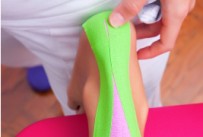Calcaneal taping and foot pain

Calcaneal taping and foot pain
Written by: Paul Kochoa, PT, DPT, OCS, CKTP, CGFI
Tape and feet, watch any sporting event on television and I’m sure you’ll spot at least one athlete with tape around their ankles. Tape is a common tool used by physiotherapists and athletic trainers to stabilize a joint, prevent injury, or correct alignment. There are so many methods to tape a foot, heel, or ankle. Depending on what the problem is and the rationale to correct it, you can ask five physios or five trainers how to address it and you’ll probably get five different answers.
The foot has several arches that run in different directions. These arches allow the foot to absorb shock and support the structures above it. The heel is comprised of a bone called the calcaneus, it is the largest bone of the foot and is an attachment point for several ligaments and tendons. When you hear of problems like plantar fasciitis or achilles tendonitis, it involves the calcaneus.
The calcaneus is a major point of control for the foot in general, and its position, among other things, can determine the stability and mobility of the foot and its arches. If you control the calcaneus, you’ll have pretty good control of the foot itself. Using various tape, you can correct calcaneal orientation and affect heel pain.
Primarily, when one talks about heel or foot pain, there can be a decreased longitudinal arch. If the arch is decreased, the ability of the foot to absorb shock and distribute weight is decreased as well. Without this mechanism in place, dysfunction and pain can be the result. Usually accompanying the decreased arch is a rotational component to the calcaneus. Both problems can occur separately or both can occur simultaneously, with one leading to the other. Which comes first? Either. Sort of a “chicken or egg” thing. Determining which to treat first is the trick.
Addressing the structures and tissues around the ankle and foot are key components to any treatment plan. The tape can be a good adjunct to therapy, correcting calcaneal rotation, increasing the arch, and thus increasing the ability of the foot to absorb and control shock. One tape method, using white low-dye tape, encompasses the heel and entire bottom surface of the foot, using the tape to create an artificial arch. Another tape method, using kinesiotape, also covers the heel and bottom surface of the foot, but with less tape.
Hyland M, et al investigated a type of taping for foot pain that addressed the calcaneus specifically. In a 2006 Journal for Orthopedic and Sports Physical Therapy, Hyland found a significant difference between a calcaneal taping with 4 strips of tape, sham taping, and stretching1. He found that taping and controlling the calcaneus significantly decreased heel pain when compared to the other treatments.
A physioherapist at Professional Physical Therapy and Training can determine the structural cause of your foot pain and prescribe the correct exercises and can apply tape in a manner that addresses your problem. Next, I’ll talk about the method that Hyland used in his study.
Up next: Calcaneal taping with 4 strips of tape
If you would like more information, please call Professional Physical Therapy and Training at 973-270-7417. Our offices our located within the YMCA locations in Madison and Summit, NJ. You do not need to be a member of the YMCA to visit with us.
1. Hyland MR, Webber-Gaffney A, Cohen L, et al. Randomized controlled trial of calcaneal taping, sham taping, and plantar fascia stretching for the short-term management of plantar heel pain. J Orthop Sports Phys Ther. 2006 Jun;36(6):364-71.
Image courtesy of Ambro / FreeDigitalPhotos.net